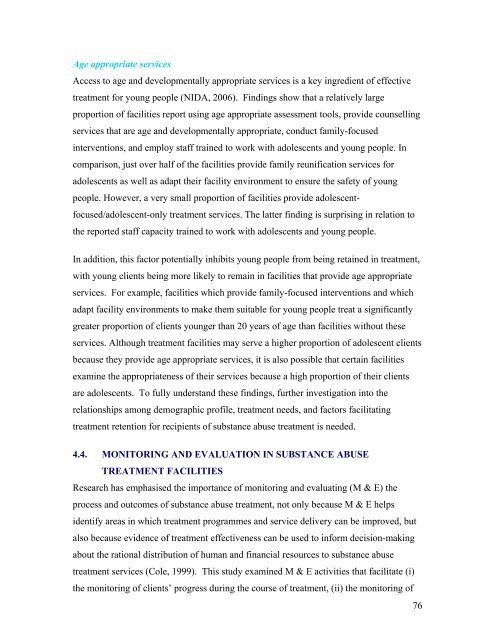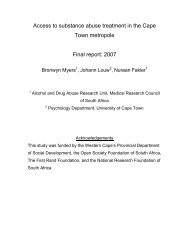Audit of Substance Abuse Treatment Facilities in ... - SA HealthInfo
Audit of Substance Abuse Treatment Facilities in ... - SA HealthInfo
Audit of Substance Abuse Treatment Facilities in ... - SA HealthInfo
- No tags were found...
Create successful ePaper yourself
Turn your PDF publications into a flip-book with our unique Google optimized e-Paper software.
Age appropriate servicesAccess to age and developmentally appropriate services is a key <strong>in</strong>gredient <strong>of</strong> effectivetreatment for young people (NIDA, 2006). F<strong>in</strong>d<strong>in</strong>gs show that a relatively largeproportion <strong>of</strong> facilities report us<strong>in</strong>g age appropriate assessment tools, provide counsell<strong>in</strong>gservices that are age and developmentally appropriate, conduct family-focused<strong>in</strong>terventions, and employ staff tra<strong>in</strong>ed to work with adolescents and young people. Incomparison, just over half <strong>of</strong> the facilities provide family reunification services foradolescents as well as adapt their facility environment to ensure the safety <strong>of</strong> youngpeople. However, a very small proportion <strong>of</strong> facilities provide adolescentfocused/adolescent-onlytreatment services. The latter f<strong>in</strong>d<strong>in</strong>g is surpris<strong>in</strong>g <strong>in</strong> relation tothe reported staff capacity tra<strong>in</strong>ed to work with adolescents and young people.In addition, this factor potentially <strong>in</strong>hibits young people from be<strong>in</strong>g reta<strong>in</strong>ed <strong>in</strong> treatment,with young clients be<strong>in</strong>g more likely to rema<strong>in</strong> <strong>in</strong> facilities that provide age appropriateservices. For example, facilities which provide family-focused <strong>in</strong>terventions and whichadapt facility environments to make them suitable for young people treat a significantlygreater proportion <strong>of</strong> clients younger than 20 years <strong>of</strong> age than facilities without theseservices. Although treatment facilities may serve a higher proportion <strong>of</strong> adolescent clientsbecause they provide age appropriate services, it is also possible that certa<strong>in</strong> facilitiesexam<strong>in</strong>e the appropriateness <strong>of</strong> their services because a high proportion <strong>of</strong> their clientsare adolescents. To fully understand these f<strong>in</strong>d<strong>in</strong>gs, further <strong>in</strong>vestigation <strong>in</strong>to therelationships among demographic pr<strong>of</strong>ile, treatment needs, and factors facilitat<strong>in</strong>gtreatment retention for recipients <strong>of</strong> substance abuse treatment is needed.4.4. MONITORING AND EVALUATION IN SUBSTANCE ABUSETREATMENT FACILITIESResearch has emphasised the importance <strong>of</strong> monitor<strong>in</strong>g and evaluat<strong>in</strong>g (M & E) theprocess and outcomes <strong>of</strong> substance abuse treatment, not only because M & E helpsidentify areas <strong>in</strong> which treatment programmes and service delivery can be improved, butalso because evidence <strong>of</strong> treatment effectiveness can be used to <strong>in</strong>form decision-mak<strong>in</strong>gabout the rational distribution <strong>of</strong> human and f<strong>in</strong>ancial resources to substance abusetreatment services (Cole, 1999). This study exam<strong>in</strong>ed M & E activities that facilitate (i)the monitor<strong>in</strong>g <strong>of</strong> clients’ progress dur<strong>in</strong>g the course <strong>of</strong> treatment, (ii) the monitor<strong>in</strong>g <strong>of</strong>76
















